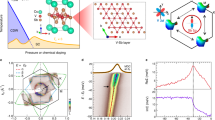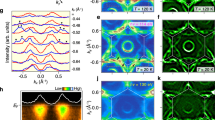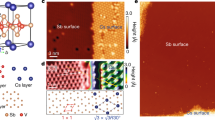Abstract
The newly discovered kagome superconductors represent a promising platform for investigating the interplay between band topology, electronic order and lattice geometry1,2,3,4,5,6,7,8,9. Despite extensive research efforts on this system, the nature of the superconducting ground state remains elusive10,11,12,13,14,15,16,17. In particular, consensus on the electron pairing symmetry has not been achieved so far18,19,20, in part owing to the lack of a momentum-resolved measurement of the superconducting gap structure. Here we report the direct observation of a nodeless, nearly isotropic and orbital-independent superconducting gap in the momentum space of two exemplary CsV3Sb5-derived kagome superconductors—Cs(V0.93Nb0.07)3Sb5 and Cs(V0.86Ta0.14)3Sb5—using ultrahigh-resolution and low-temperature angle-resolved photoemission spectroscopy. Remarkably, such a gap structure is robust to the appearance or absence of charge order in the normal state, tuned by isovalent Nb/Ta substitutions of V. Our comprehensive characterizations of the superconducting gap provide indispensable information on the electron pairing symmetry of kagome superconductors, and advance our understanding of the superconductivity and intertwined electronic orders in quantum materials.
This is a preview of subscription content, access via your institution
Access options
Access Nature and 54 other Nature Portfolio journals
Get Nature+, our best-value online-access subscription
$29.99 / 30 days
cancel any time
Subscribe to this journal
Receive 51 print issues and online access
$199.00 per year
only $3.90 per issue
Buy this article
- Purchase on Springer Link
- Instant access to full article PDF
Prices may be subject to local taxes which are calculated during checkout




Similar content being viewed by others
Data availability
Data are available from the corresponding author upon reasonable request.
References
Syôzi, I. Statistics of kagomé lattice. Prog. Theor. Phys. 6, 306–308 (1951).
Yu, S.-L. & Li, J.-X. Chiral superconducting phase and chiral spin-density-wave phase in a Hubbard model on the kagome lattice. Phys. Rev. B 85, 144402 (2012).
Kiesel, M. L., Platt, C. & Thomale, R. Unconventional Fermi surface instabilities in the kagome Hubbard model. Phys. Rev. Lett. 110, 126405 (2013).
Wang, W.-S., Li, Z.-Z., Xiang, Y.-Y. & Wang, Q.-H. Competing electronic orders on kagome lattices at van Hove filling. Phys. Rev. B 87, 115135 (2013).
Ortiz, B. R. et al. New kagome prototype materials: discovery of KV3Sb5, RbV3Sb5, and CsV3Sb5. Phys. Rev. Mater. 3, 094407 (2019).
Ortiz, B. R. et al. CsV3Sb5: a Z2 topological kagome metal with a superconducting ground state. Phys. Rev. Lett. 125, 247002 (2020).
Yin, J.-X., Lian, B. & Hasan, M. Z. Topological kagome magnets and superconductors. Nature 612, 647–657 (2022).
Jiang, Y.-X. et al. Unconventional chiral charge order in kagome superconductor KV3Sb5. Nat. Mater. 20, 1353–1357 (2021).
Mielke, C. et al. Time-reversal symmetry-breaking charge order in a kagome superconductor. Nature 602, 245–250 (2022).
Chen, H. et al. Roton pair density wave in a strong-coupling kagome superconductor. Nature 599, 222–228 (2021).
Xu, H.-S. et al. Multiband superconductivity with sign-preserving order parameter in kagome superconductor CsV3Sb5. Phys. Rev. Lett. 127, 187004 (2021).
Zhao, C. et al. Nodal superconductivity and superconducting domes in the topological Kagome metal CsV3Sb5. Preprint at https://doi.org/10.48550/arXiv.2102.08356 (2021).
Mu, C. et al. S-wave superconductivity in kagome metal CsV3Sb5 revealed by 121/123Sb NQR and 51V NMR measurements. Chin. Phys. Lett. 38, 077402 (2021).
Duan, W. et al. Nodeless superconductivity in the kagome metal CsV3Sb5. Sci. China Phys. Mech. Astron. 64, 107462 (2021).
Gupta, R. et al. Microscopic evidence for anisotropic multigap superconductivity in the CsV3Sb5 kagome superconductor. npj Quantum Mater. 7, 49 (2022).
Guguchia, Z. et al. Tunable nodal kagome superconductivity in charge ordered RbV3Sb5. Nat. Commun. 14, 153 (2022).
Lou, R. et al. Charge-density-wave-induced peak-dip-hump structure and the multiband superconductivity in a kagome superconductor CsV3Sb5. Phys. Rev. Lett. 128, 036402 (2022).
Wu, X. et al. Nature of unconventional pairing in the kagome superconductors AV3Sb5 (A = K, Rb, Cs). Phys. Rev. Lett. 127, 177001 (2021).
Tazai, R., Yamakawa, Y., Onari, S. & Kontani, H. Mechanism of exotic density-wave and beyond-Migdal unconventional superconductivity in kagome metal AV3Sb5 (A = K, Rb, Cs). Sci. Adv. 8, eabl4108 (2022).
Gu, Y., Zhang, Y., Feng, X., Jiang, K. & Hu, J. Gapless excitations inside the fully gapped kagome superconductors AV3Sb5. Phys. Rev. B 105, L100502 (2022).
Keimer, B., Kivelson, S. A., Norman, M. R., Uchida, S. & Zaanen, J. From quantum matter to high-temperature superconductivity in copper oxides. Nature 518, 179–186 (2015).
Fernandes, R. M. et al. Iron pnictides and chalcogenides: a new paradigm for superconductivity. Nature 601, 35–44 (2022).
He, R.-H. et al. Energy gaps in the failed high-Tc superconductor La1.875Ba0.125CuO4. Nat. Phys. 5, 119–123 (2009).
Neupert, T., Denner, M. M., Yin, J.-X., Thomale, R. & Hasan, M. Z. Charge order and superconductivity in kagome materials. Nat. Phys. 18, 137–143 (2021).
Khasanov, R. et al. Time-reversal symmetry broken by charge order in CsV3Sb5. Phys. Rev. Res. 4, 023244 (2022).
Xu, Y. et al. Three-state nematicity and magneto-optical Kerr effect in the charge density waves in kagome superconductors. Nat. Phys. 18, 1470–1475 (2022).
Xiang, Y. et al. Twofold symmetry of c-axis resistivity in topological kagome superconductor CsV3Sb5 with in-plane rotating magnetic field. Nat. Commun. 12, 6727 (2021).
Li, H. et al. Rotation symmetry breaking in the normal state of a kagome superconductor KV3Sb5. Nat. Phys. 18, 265–270 (2022).
Chen, K. et al. Double superconducting dome and triple enhancement of Tc in the kagome superconductor CsV3Sb5 under high pressure. Phys. Rev. Lett. 126, 247001 (2021).
Yu, F. et al. Unusual competition of superconductivity and charge-density-wave state in a compressed topological kagome metal. Nat. Commun. 12, 3645 (2021).
Yang, S.-Y. et al. Giant, unconventional anomalous Hall effect in the metallic frustrated magnet candidate, KV3Sb5. Sci. Adv. 6, eabb6003 (2020).
Yu, F. et al. Concurrence of anomalous Hall effect and charge density wave in a superconducting topological kagome metal. Phys. Rev. B 104, L041103 (2021).
Sobota, J. A., He, Y. & Shen, Z.-X. Angle-resolved photoemission studies of quantum materials. Rev. Mod. Phys. 93, 025006 (2021).
Kang, M. et al. Twofold van Hove singularity and origin of charge order in topological kagome superconductor CsV3Sb5. Nat. Phys. 18, 301–308 (2022).
Hu, Y. et al. Rich nature of Van Hove singularities in Kagome superconductor CsV3Sb5. Nat. Commun. 13, 2220 (2022).
Li, Y. et al. Tuning the competition between superconductivity and charge order in the kagome superconductor Cs(V1−xNbx)3Sb5. Phys. Rev. B 105, L180507 (2022).
Luo, H. et al. Electronic nature of charge density wave and electron-phonon coupling in kagome superconductor KV3Sb5. Nat. Commun. 13, 273 (2022).
Zhong, Y. et al. Testing electron-phonon coupling for the superconductivity in kagome metal CsV3Sb5. Preprint at https://doi.org/10.48550/arXiv.2207.02407 (2022).
Gupta, R. et al. Two types of charge order with distinct interplay with superconductivity in the kagome material CsV3Sb5. Commun. Phys. 5, 232 (2022).
Shimojima, T., Okazaki, K. & Shin, S. Low-temperature and high-energy-resolution laser photoemission spectroscopy. J. Phys. Soc. Jpn 84, 072001 (2015).
Reber, T., Plumb, N., Waugh, J. & Dessau, D. Effects, determination, and correction of count rate nonlinearity in multi-channel analog electron detectors. Rev. Sci. Instrum. 85, 043907 (2014).
Matsui, H. et al. BCS-like Bogoliubov quasiparticles in high-Tc superconductors observed by angle-resolved photoemission spectroscopy. Phys. Rev. Lett. 90, 217002 (2003).
Shimojima, T. et al. Orbital-independent superconducting gaps in iron pnictides. Science 332, 564–567 (2011).
Okazaki, K. et al. Octet-line node structure of superconducting order parameter in KFe2As2. Science 337, 1314–1317 (2012).
Li, C. et al. Coexistence of two intertwined charge density waves in a kagome system. Phys. Rev. Res. 4, 033072 (2021).
Valla, T., Fedorov, A. V., Johnson, P. D. & Hulbert, S. L. Many-body effects in angle-resolved photoemission: quasiparticle energy and lifetime of a Mo(110) surface state. Phys. Rev. Lett. 83, 2085–2088 (1999).
Lanzara, A. et al. Evidence for ubiquitous strong electron–phonon coupling in high-temperature superconductors. Nature 412, 510–514 (2001).
Johnson, P. et al. Doping and temperature dependence of the mass enhancement observed in the cuprate Bi2Sr2CaCu2O8+δ. Phys. Rev. Lett. 87, 177007 (2001).
Acknowledgements
We thank W. Zhang, S. Huh and M. Liu for stimulating discussions. This work was supported by the National Key Research and Development Program of China (grant nos 2020YFA0308800 and 2022YFA1403400), the Grants-in-Aid for Scientific Research (KAKENHI) (grant nos JP18K13498, JP19H01818, JP19H00651 and JP21H04439) from the Japan Society for the Promotion of Science (JSPS), JSPS KAKENHI on Innovative Areas ‘Quantum Liquid Crystals’ (grant no. JP19H05826), the Center of Innovation Program from the Japan Science and Technology Agency (JST) and MEXT Quantum Leap Flagship Program of Japan (MEXT Q-LEAP) (grant no. JPMXS0118068681), the National Science Foundation of China (grant nos 12061131002, 12234003 and 92065109),. and the Beijing Natural Science Foundation (grant nos Z210006 and Z190006). X.S. was supported by the Beijing Institute of Technology (BIT) Research Fund Program for Young Scholars. Z.W. thanks the Analysis and Testing Center at BIT for assistance in facility support. J.-X.Y. was supported by South University of Science and Technology of China principal research grant (no. Y01202500). X.H. acknowledges the support from the China Postdoctoral Science Foundation Fellowship (no. 2022M723112). J.H. was supported by the Ministry of Science and Technology of China (grant no. 2022YFA1403901) and the National Natural Science Foundation of China (grant no. NSFC-1188810).
Author information
Authors and Affiliations
Contributions
Y.Z., X.S. and K.O. conceived the project. Y.Z. performed the ARPES experiments with assistance from A.M., S.N., T.S. and K.L., and with guidance from T.K. and K.O. Z.G., J.-X.Y., D.D., C.M.III, R.K. and H.L. contributed to interpretation of data and making a conclusion. J.L., Y.L. and Z.W. grew the samples and performed sample characterizations. X.W. performed the band calculations. X.W., X.H. and J.H. contributed to theoretical inputs. Y.Z., X.S., X.W., J.-X.Y. and K.O. prepared the manuscript with input from all authors.
Corresponding authors
Ethics declarations
Competing interests
The authors declare no competing interests.
Peer review information
Peer review information
Nature thanks Myung Joon Han and the other, anonymous, reviewer(s) for their contribution to the peer review of this work.
Additional information
Publisher’s note Springer Nature remains neutral with regard to jurisdictional claims in published maps and institutional affiliations.
Extended data figures and tables
Extended Data Fig. 1 Fermi surface evolution upon Nb/V substitutions.
a–c, Fermi surface maps integrated over EF ± 5 meV for the pristine, 7%-Nb and 14%-Ta substituted CsV3Sb5 samples, respectively. The spectra were measured with He Iα photons (hν = 21.218 eV) at T = 7 K. d, Line cuts along kx = 0. The black lines are the Lorentizen fits to determine the kF positions. e, Summary of the kF evolution of three Fermi surfaces upon Nb/V substitutions. The error bars represent the uncertainties of the fits.
Extended Data Fig. 2 Fermi surfaces of all measured Ta0.14 samples.
a–d, ARPES intensity integrated over EF ± 5 meV. e–h, kF points at which the superconducting gap is measured.
Extended Data Fig. 3 Fermi surfaces of all measured Nb0.07 samples.
a–d, ARPES intensity integrated over EF ± 5 meV. e–h, kF points at which the superconducting gap is measured.
Extended Data Fig. 4 Superconducting gap at different kz for the Cs(V0.93Nb0.07)3Sb5 sample.
a, FS map taken with 5.8-eV laser. b, EDCs at kF marked in a. The black lines are the fits of these EDCs. c, Symmetrized EDCs for b. d–f, Same as a-c but for the data taken with 7-eV laser. The curves are vertically offset for clarity. g. Comparison of the SC gap amplitude measured with 5.8-eV and 7-eV laser. The inset shows the kz positions corresponding to these two photon energies.
Extended Data Fig. 5 X-ray diffraction (XRD) measurements.
a, XRD of the pristine CsV3Sb5, Nb0.07 and Ta0.14 single crystals. b, Extracted in-plane lattice constants for these three single crystals.
Extended Data Fig. 6 Spectral evidence of the electron-phonon coupling.
a–c, ARPES intensity plots of the α and β bands nearly along Γ−Κ direction for the pristine CsV3Sb5, Nb0.07 and Ta0.14 samples, respectively. These ARPES data are taken with 7-eV laser at T = 6 K. d–f, Extracted band dispersions. a and d are adopted from the ref. 38, in which the Tc of the measured CsV3Sb5 is approximately 2.5 K. g, Ratio between the velocity of the bare band and the Fermi velocity for the pristine, Nb0.07 and Ta0.14 samples, plotted as a function of their Tc.
Extended Data Fig. 7 Comparison of the van Hove singularities.
a–c, ARPES intensity plots along K-M-K direction for pristine, 7%-Nb and 14%-Ta substituted CsV3Sb5, respectively. These ARPES measurements were performed using a photon energy hν = 21.218 eV (He Iα). d–e, Curvature plots of a–c near EF in energy and around M point in momentum. g, EDCs extracted at M point. The arrows mark the peak positions of these EDCs. h, Band dispersion around M point extracted from the curvature plots.
Extended Data Fig. 8 Calculated band structures for the CsV3Sb5, Cs(V0.93Nb0.07)3Sb5 and Cs(V0.86Ta0.14)3Sb5 samples based on density functional theory.
The experimentally determined lattice constants are used in the calculation.
Rights and permissions
Springer Nature or its licensor (e.g. a society or other partner) holds exclusive rights to this article under a publishing agreement with the author(s) or other rightsholder(s); author self-archiving of the accepted manuscript version of this article is solely governed by the terms of such publishing agreement and applicable law.
About this article
Cite this article
Zhong, Y., Liu, J., Wu, X. et al. Nodeless electron pairing in CsV3Sb5-derived kagome superconductors. Nature 617, 488–492 (2023). https://doi.org/10.1038/s41586-023-05907-x
Received:
Accepted:
Published:
Issue Date:
DOI: https://doi.org/10.1038/s41586-023-05907-x
This article is cited by
-
Electronic landscape of kagome superconductors AV3Sb5 (A = K, Rb, Cs) from angle-resolved photoemission spectroscopy
npj Quantum Materials (2023)
Comments
By submitting a comment you agree to abide by our Terms and Community Guidelines. If you find something abusive or that does not comply with our terms or guidelines please flag it as inappropriate.



